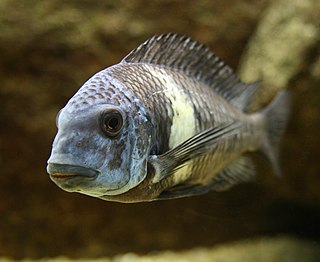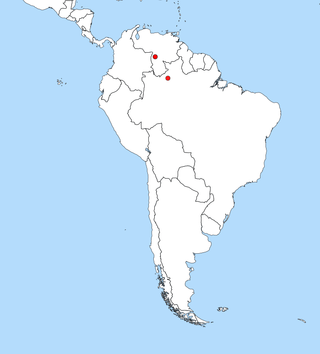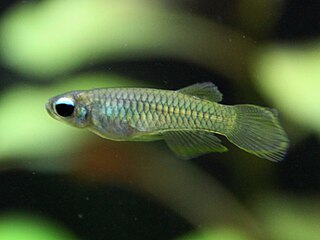
Sterba's corydoras is a member of the South American Corydoras genus of freshwater aquarium catfish and one of the most popular species of Corydoras due to its attractive markings. The fish is native to the Guaporé River region between Bolivia and Brazil.

Maylandia estherae is a haplochromine cichlid. It is a rock dwelling fish or mbuna from Lake Malawi. This fish, like most cichlids from Lake Malawi, is a mouthbrooder - females hold their fertilized eggs then fry in their mouths until they are released after about 21 days.

Poecilia wingei, known to aquarists as Endlers or Endler's livebearer, in the genus Poecilia, is a small fish native to the Paria Peninsula in Venezuela. They are prolific breeders and often hybridize with guppies. These very colorful hybrids are the easiest to find being offered in pet-shops, typically under the name Endler's guppy.

Iodotropheus sprengerae, the rusty cichlid, lavender mbuna or lavender cichlid, is a species of cichlid endemic to the Boadzulu and Chinyankwazi Islands and Chinyamwezi Island regions of Lake Malawi. It prefers a temperature range of 24-26 °C.

Thayeria boehlkei is a species of characin fish endemic to the Amazon River basin and Araguaia River, in Peru and Brazil respectively. The species is popular with aquarium hobbyists where it is traded under a variety of common names including blackline penguinfish, blackline thayeria, hockey-stick tetra, penguin fish and penguin tetra.
George Sprague Myers was an American ichthyologist who spent most of his career at Stanford University. He served as the editor of Stanford Ichthyological Bulletin as well as president of the American Society of Ichthyologists and Herpetologists. Myers was also head of the Division of Fishes at the United States National Museum, and held a position as an ichthyologist for the United States Fish and Wildlife Service. He was also an advisor in fisheries and ichthyology to the Brazilian Government.

Chalinochromis brichardi is a species of fish in the family Cichlidae. It is found in Burundi, the Democratic Republic of the Congo, Tanzania, and Zambia. It is endemic to Lake Tanganyika. It builds a nest of rubble which is hidden by plants or algae, and its diet consists primarily of invertebrates. The specific name of this fish honours the fish dealer Pierre Brichard (1921-1990), who was the collector of the type.
The threadfin cichlid is a species of cichlid endemic to Lake Tanganyika found in areas with rocky substrates on which it can graze on algae. This species can reach a length of 18 cm (7.1 in). It can be found in the aquarium trade. The specific name of this cichlid honours the British ichthyologist Ethelwynn Trewavas (1900-1993).

The electric blue hap is a species of cichlid fish endemic to Lake Malawi. It prefers to live in caves and crevices in rocky substrates. This species can reach a length of 20 centimetres (7.9 in) TL. It can also be found in the aquarium trade.

Tropheus duboisi, the white spotted cichlid, is a species of cichlid endemic to Lake Tanganyika. It can reach a length of 12 cm (4.7 in).
The Chiapas swordtail or upland swordtail is a species of livebearing freshwater fish of family Poeciliidae, and genus Xiphophorus. It is, therefore, in the same genus as the common platy and the swordtail. The Chiapas swordtail was discovered and first described by Donn E. Rosen in 1960, along with four other species of Xiphophorus.

The ember tetra is a freshwater fish of the characin family of order Characiformes. It is native to the Araguaia River basin of Brazil and was discovered in 1987 and named in honor of the fish explorer Heiko Bleher's mother.

Nematobrycon palmeri, commonly known as the emperor tetra, is a species of characid fish found in the Atrato and San Juan river basins in western Colombia. It was first imported in the aquarium trade to the United States in 1960 and has since become well established.

Nannostomus anduzei is a freshwater species of fish belonging to the genus Nannostomus in the characin family Lebiasinidae. It is native to Venezuela and northern Brazil, particularly the upper Orinoco and Rio Ererê, a tributary of the Rio Negro. The adults grow to a maximum length of only 16 mm, making them one of the smallest pencilfish. Other common names include miniature pencilfish, miniature nannostomus, and Anduzi's nannostomus.

The pike topminnow, more commonly known as pike killifish and sometimes referred to as topminnow, is a species of poeciliid found from Mexico to Nicaragua. It has also been introduced to Florida, USA. It is the only known member of its genus. The pike topminnow was described in 1860 by Austrian ichthyologist Rudolf Kner, who gave the type locality as Belize, which is reflected in this species' specific name.

Poecilia parae, also known as the melanzona guppy, is a species of fish from the family Poeciliidae which is found in northern South America from Guyana to the mouth of the Amazon River.

Poropanchax normani, also known as the Norman's lampeye, is a species of Poeciliidae native to Africa.
Cnesterodon raddai, the Resistencia toothcarp, is a species of poeciliid native to the Paraguay and lower Paraná River basins.

Cnesterodon decemmaculatus, the ten spotted live-bearer, is a species of poeciliid native to Argentina and Uruguay.
Cnesterodon pirai, the Almeida toothcarp, is a species of poeciliid that is only know from its type locality, the arroyo Almeida, an affluent of the arroyo Cuñá-Pirú, in the Río Paraná basin, Aristóbulo del Valle, Misiones in Argentina.















